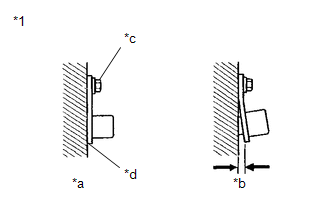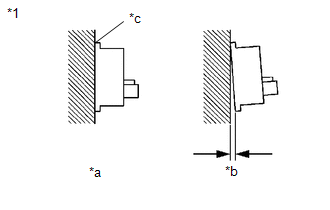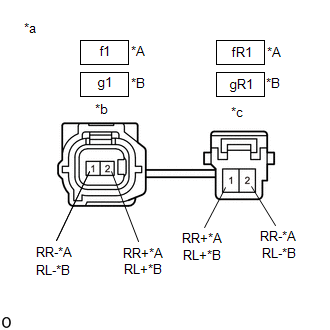| Last Modified: 09-09-2025 | 6.11:8.1.0 | Doc ID: RM1000000012SY3 |
| Model Year Start: 2018 | Model: Camry | Prod Date Range: [03/2017 - 06/2017] |
| Title: BRAKE CONTROL / DYNAMIC CONTROL SYSTEMS: VEHICLE STABILITY CONTROL SYSTEM: C1330-C1333,C1464-C1467; Open in Front Speed Sensor RH; 2018 MY Camry [03/2017 - 06/2017] | ||
|
DTC |
C1330 |
Open in Front Speed Sensor RH |
|
DTC |
C1331 |
Open in Front Speed Sensor LH |
|
DTC |
C1332 |
Open in Rear Speed Sensor RH |
|
DTC |
C1333 |
Open in Rear Speed Sensor LH |
|
DTC |
C1464 |
Front Speed Sensor RH |
|
DTC |
C1465 |
Front Speed Sensor LH |
|
DTC |
C1466 |
Rear Speed Sensor RH |
|
DTC |
C1467 |
Rear Speed Sensor LH |
DESCRIPTION
Each speed sensor detects wheel speed and sends signals to the skid control ECU (brake actuator assembly). These signals are used by the ABS control.
HINT:
The output voltage values shown below are for when the vehicle wire harnesses are connected to the skid control ECU (brake actuator assembly) and the speed sensors.
for Front
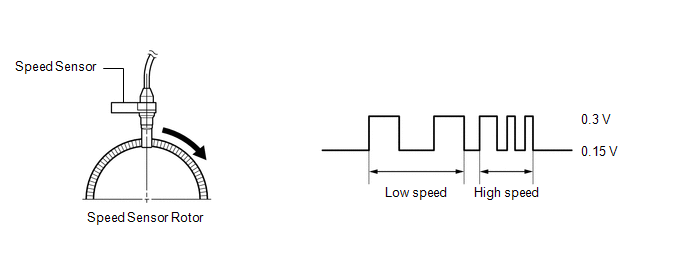
for Rear
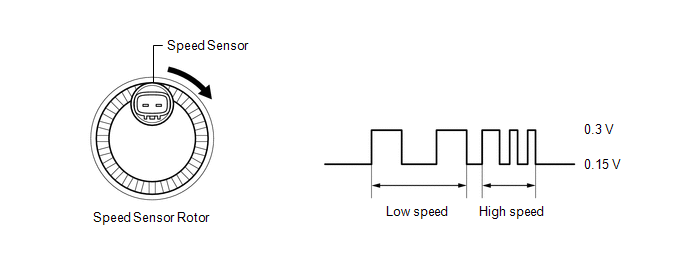
|
DTC No. |
Detection Item |
DTC Detection Condition |
Trouble Area |
|---|---|---|---|
|
C1330 |
Open in Front Speed Sensor RH |
An open or short in the speed sensor signal circuit. |
|
|
C1331 |
Open in Front Speed Sensor LH |
An open or short in the speed sensor signal circuit. |
|
|
C1332 |
Open in Rear Speed Sensor RH |
An open or short in the speed sensor signal circuit. |
|
|
C1333 |
Open in Rear Speed Sensor LH |
An open or short in the speed sensor signal circuit. |
|
|
C1464 |
Front Speed Sensor RH |
Any of the following is detected:
|
|
|
C1465 |
Front Speed Sensor LH |
Any of the following is detected:
|
|
|
C1466 |
Rear Speed Sensor RH |
Any of the following is detected:
|
|
|
C1467 |
Rear Speed Sensor LH |
Any of the following is detected:
|
|
HINT:
- DTCs C1330 and C1464 are for the front speed sensor RH.
- DTCs C1331 and C1465 are for the front speed sensor LH.
- DTCs C1332 and C1466 are for the rear speed sensor RH.
- DTCs C1333 and C1467 are for the rear speed sensor LH.
DTC Detection Conditions: C1464
|
Vehicle Condition |
|||||
|---|---|---|---|---|---|
|
Pattern 1 |
Pattern 2 |
Pattern 3 |
Pattern 4 |
||
|
Diagnosis Condition |
The vehicle speed is more than 50.4 km/h (31 mph). |
○ |
- |
- |
- |
|
After the initial start or restart and when the vehicle speed has reached 12 km/h (7 mph). |
- |
○ |
- |
- |
|
|
After the initial start or restart and when the vehicle speed has reached 20 km/h (12 mph). |
- |
- |
○ |
- |
|
|
Malfunction Status |
Pulses are not detected. |
○ |
- |
- |
- |
|
A wheel speed of 0 km/h (0 mph) is detected. |
- |
○ |
- |
- |
|
|
A front wheel speed of 0 km/h (0 mph) is detected. |
- |
- |
○ |
- |
|
|
The difference between the speed of the fastest wheel and the speed of the slowest wheel is 5% or more of the vehicle speed. (If the speed of any wheel is less than 5 km/h (3 mph), a speed difference of up to 15% is allowable.) |
- |
- |
- |
○ |
|
|
Detection Time |
0.4 seconds |
- |
- |
9 to 72 seconds or more (varies depending on the driving conditions) |
|
|
Number of Trips |
1 trip |
1 trip |
1 trip |
1 trip |
|
HINT:
DTC will be output when conditions for either of the patterns in the table above are met.
DTC Detection Conditions: C1464
|
Vehicle Condition |
|||||
|---|---|---|---|---|---|
|
Pattern 5 |
Pattern 6 |
Pattern 7 |
Pattern 8 |
||
|
Diagnosis Condition |
The vehicle speed is less than 100 km/h (62 mph). |
○ |
- |
- |
- |
|
The vehicle speed is 100 km/h (62 mph) or more. |
- |
○ |
- |
- |
|
|
Malfunction Status |
The difference between the speed of the fastest wheel and the speed of the slowest wheel is 5 km/h (3 mph) or more. (If the speed of any wheel is less than 5 km/h (3 mph), a speed difference of up to 16 km/h (10 mph) is allowable.) |
○ |
- |
- |
- |
|
The difference between the speed of the fastest wheel and the speed of the slowest wheel is 6% or more of the vehicle speed. (If the speed of any wheel is less than 5 km/h (3 mph), a speed difference of up to 15% is allowable.) |
- |
○ |
- |
- |
|
|
Wheel speed sensor signal fluctuation is equivalent to 98 G or more, or alternates between 50 G or more and -50 G or less. |
- |
- |
○ |
- |
|
|
An abnormal signal is received from a wheel speed sensor. |
- |
- |
- |
○ |
|
|
Detection Time |
9 to 72 seconds or more (varies depending on the driving conditions) |
9 to 72 seconds or more (varies depending on the driving conditions) |
- |
- |
|
|
Number of Trips |
1 trip |
1 trip |
1 trip |
1 trip |
|
HINT:
DTC will be output when conditions for either of the patterns in the table above are met.
DTC Detection Conditions: C1465
|
Vehicle Condition |
|||||
|---|---|---|---|---|---|
|
Pattern 1 |
Pattern 2 |
Pattern 3 |
Pattern 4 |
||
|
Diagnosis Condition |
The vehicle speed is more than 50.4 km/h (31 mph). |
○ |
- |
- |
- |
|
After the initial start or restart and when the vehicle speed has reached 12 km/h (7 mph). |
- |
○ |
- |
- |
|
|
After the initial start or restart and when the vehicle speed has reached 20 km/h (12 mph). |
- |
- |
○ |
- |
|
|
Malfunction Status |
Pulses are not detected. |
○ |
- |
- |
- |
|
A wheel speed of 0 km/h (0 mph) is detected. |
- |
○ |
- |
- |
|
|
A front wheel speed of 0 km/h (0 mph) is detected. |
- |
- |
○ |
- |
|
|
The difference between the speed of the fastest wheel and the speed of the slowest wheel is 5% or more of the vehicle speed. (If the speed of any wheel is less than 5 km/h (3 mph), a speed difference of up to 15% is allowable.) |
- |
- |
- |
○ |
|
|
Detection Time |
0.4 seconds |
- |
- |
9 to 72 seconds or more (varies depending on the driving conditions) |
|
|
Number of Trips |
1 trip |
1 trip |
1 trip |
1 trip |
|
HINT:
DTC will be output when conditions for either of the patterns in the table above are met.
DTC Detection Conditions: C1465
|
Vehicle Condition |
|||||
|---|---|---|---|---|---|
|
Pattern 5 |
Pattern 6 |
Pattern 7 |
Pattern 8 |
||
|
Diagnosis Condition |
The vehicle speed is less than 100 km/h (62 mph). |
○ |
- |
- |
- |
|
The vehicle speed is 100 km/h (62 mph) or more. |
- |
○ |
- |
- |
|
|
Malfunction Status |
The difference between the speed of the fastest wheel and the speed of the slowest wheel is 5 km/h (3 mph) or more. (If the speed of any wheel is less than 5 km/h (3 mph), a speed difference of up to 16 km/h (10 mph) is allowable.) |
○ |
- |
- |
- |
|
The difference between the speed of the fastest wheel and the speed of the slowest wheel is 6% or more of the vehicle speed. (If the speed of any wheel is less than 5 km/h (3 mph), a speed difference of up to 15% is allowable.) |
- |
○ |
- |
- |
|
|
Wheel speed sensor signal fluctuation is equivalent to 98 G or more, or alternates between 50 G or more and -50 G or less. |
- |
- |
○ |
- |
|
|
An abnormal signal is received from a wheel speed sensor. |
- |
- |
- |
○ |
|
|
Detection Time |
9 to 72 seconds or more (varies depending on the driving conditions) |
9 to 72 seconds or more (varies depending on the driving conditions) |
- |
- |
|
|
Number of Trips |
1 trip |
1 trip |
1 trip |
1 trip |
|
HINT:
DTC will be output when conditions for either of the patterns in the table above are met.
DTC Detection Conditions: C1466
|
Vehicle Condition |
|||||
|---|---|---|---|---|---|
|
Pattern 1 |
Pattern 2 |
Pattern 3 |
Pattern 4 |
||
|
Diagnosis Condition |
The vehicle speed is more than 50.4 km/h (31 mph). |
○ |
- |
- |
- |
|
After the initial start or restart and when the vehicle speed has reached 12 km/h (7 mph). |
- |
○ |
- |
- |
|
|
After the initial start or restart and when the vehicle speed has reached 20 km/h (12 mph). |
- |
- |
○ |
- |
|
|
Malfunction Status |
Pulses are not detected. |
○ |
- |
- |
- |
|
A wheel speed of 0 km/h (0 mph) is detected. |
- |
○ |
- |
- |
|
|
A rear wheel speed of 0 km/h (0 mph) is detected. |
- |
- |
○ |
- |
|
|
The difference between the speed of the fastest wheel and the speed of the slowest wheel is 5% or more of the vehicle speed. (If the speed of any wheel is less than 5 km/h (3 mph), a speed difference of up to 15% is allowable.) |
- |
- |
- |
○ |
|
|
Detection Time |
0.4 seconds |
- |
- |
9 to 72 seconds or more (varies depending on the driving conditions) |
|
|
Number of Trips |
1 trip |
1 trip |
1 trip |
1 trip |
|
HINT:
DTC will be output when conditions for either of the patterns in the table above are met.
DTC Detection Conditions: C1466
|
Vehicle Condition |
|||||
|---|---|---|---|---|---|
|
Pattern 5 |
Pattern 6 |
Pattern 7 |
Pattern 8 |
||
|
Diagnosis Condition |
The vehicle speed is less than 100 km/h (62 mph). |
○ |
- |
- |
- |
|
The vehicle speed is 100 km/h (62 mph) or more. |
- |
○ |
- |
- |
|
|
Malfunction Status |
The difference between the speed of the fastest wheel and the speed of the slowest wheel is 5 km/h (3 mph) or more. (If the speed of any wheel is less than 5 km/h (3 mph), a speed difference of up to 16 km/h (10 mph) is allowable.) |
○ |
- |
- |
- |
|
The difference between the speed of the fastest wheel and the speed of the slowest wheel is 6% or more of the vehicle speed. (If the speed of any wheel is less than 5 km/h (3 mph), a speed difference of up to 15% is allowable.) |
- |
○ |
- |
- |
|
|
Wheel speed sensor signal fluctuation is equivalent to 98 G or more, or alternates between 50 G or more and -50 G or less. |
- |
- |
○ |
- |
|
|
An abnormal signal is received from a wheel speed sensor. |
- |
- |
- |
○ |
|
|
Detection Time |
9 to 72 seconds or more (varies depending on the driving conditions) |
9 to 72 seconds or more (varies depending on the driving conditions) |
- |
- |
|
|
Number of Trips |
1 trip |
1 trip |
1 trip |
1 trip |
|
HINT:
DTC will be output when conditions for either of the patterns in the table above are met.
DTC Detection Conditions: C1467
|
Vehicle Condition |
|||||
|---|---|---|---|---|---|
|
Pattern 1 |
Pattern 2 |
Pattern 3 |
Pattern 4 |
||
|
Diagnosis Condition |
The vehicle speed is more than 50.4 km/h (31 mph). |
○ |
- |
- |
- |
|
After the initial start or restart and when the vehicle speed has reached 12 km/h (7 mph). |
- |
○ |
- |
- |
|
|
After the initial start or restart and when the vehicle speed has reached 20 km/h (12 mph). |
- |
- |
○ |
- |
|
|
Malfunction Status |
Pulses are not detected. |
○ |
- |
- |
- |
|
A wheel speed of 0 km/h (0 mph) is detected. |
- |
○ |
- |
- |
|
|
A rear wheel speed of 0 km/h (0 mph) is detected. |
- |
- |
○ |
- |
|
|
The difference between the speed of the fastest wheel and the speed of the slowest wheel is 5% or more of the vehicle speed. (If the speed of any wheel is less than 5 km/h (3 mph), a speed difference of up to 15% is allowable.) |
- |
- |
- |
○ |
|
|
Detection Time |
0.4 seconds |
- |
- |
9 to 72 seconds or more (varies depending on the driving conditions) |
|
|
Number of Trips |
1 trip |
1 trip |
1 trip |
1 trip |
|
HINT:
DTC will be output when conditions for either of the patterns in the table above are met.
DTC Detection Conditions: C1467
|
Vehicle Condition |
|||||
|---|---|---|---|---|---|
|
Pattern 5 |
Pattern 6 |
Pattern 7 |
Pattern 8 |
||
|
Diagnosis Condition |
The vehicle speed is less than 100 km/h (62 mph). |
○ |
- |
- |
- |
|
The vehicle speed is 100 km/h (62 mph) or more. |
- |
○ |
- |
- |
|
|
Malfunction Status |
The difference between the speed of the fastest wheel and the speed of the slowest wheel is 5 km/h (3 mph) or more. (If the speed of any wheel is less than 5 km/h (3 mph), a speed difference of up to 16 km/h (10 mph) is allowable.) |
○ |
- |
- |
- |
|
The difference between the speed of the fastest wheel and the speed of the slowest wheel is 6% or more of the vehicle speed. (If the speed of any wheel is less than 5 km/h (3 mph), a speed difference of up to 15% is allowable.) |
- |
○ |
- |
- |
|
|
Wheel speed sensor signal fluctuation is equivalent to 98 G or more, or alternates between 50 G or more and -50 G or less. |
- |
- |
○ |
- |
|
|
An abnormal signal is received from a wheel speed sensor. |
- |
- |
- |
○ |
|
|
Detection Time |
9 to 72 seconds or more (varies depending on the driving conditions) |
9 to 72 seconds or more (varies depending on the driving conditions) |
- |
- |
|
|
Number of Trips |
1 trip |
1 trip |
1 trip |
1 trip |
|
HINT:
DTC will be output when conditions for either of the patterns in the table above are met.
WIRING DIAGRAM
for Front
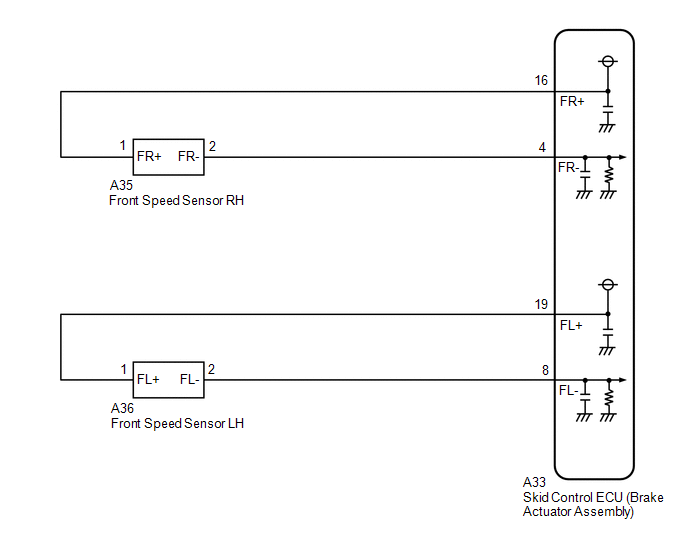
for Rear
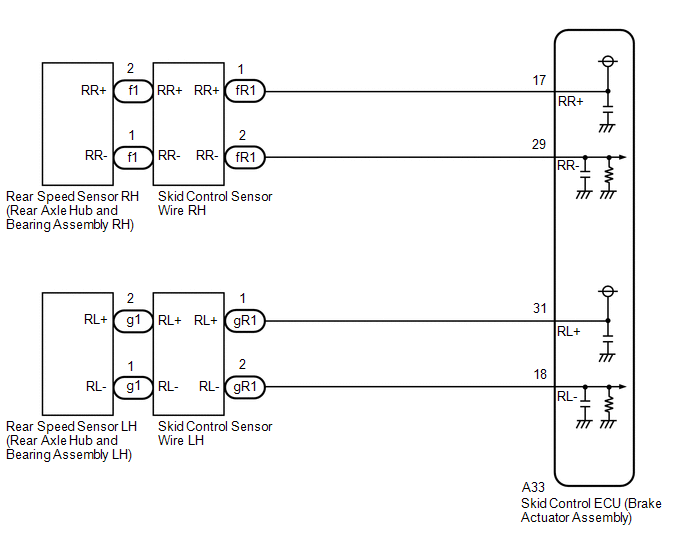
CAUTION / NOTICE / HINT
NOTICE:
When replacing the skid control ECU (brake actuator assembly), perform system variant learning and acceleration sensor zero point calibration.
PROCEDURE
PROCEDURE
|
1. |
RECONFIRM DTC |
(a) Clear the DTCs.
Chassis > ABS/VSC/TRAC > Clear DTCs
(b) Turn the ignition switch off.
(c) Start the engine.
(d) Drive the vehicle at a speed of 54 km/h (34 mph) or more for at least 120 seconds.
(e) Check if the same DTC is output.
Chassis > ABS/VSC/TRAC > Trouble Codes
|
Result |
Proceed to |
|---|---|
|
C1330, C1331, C1464 or C1465 is output |
A |
|
C1332, C1333, C1466 or C1467 is output |
B |
| B |

|
|
|
2. |
CHECK FRONT SPEED SENSOR INSTALLATION |
|
(a) Turn the ignition switch off. |
|
(b) Check the speed sensor installation.
OK:
There is no clearance between the sensor and the front steering knuckle.
The installation bolt is tightened properly.
Torque
8.5 N*m (87 kgf*cm, 75 in.*lbf)
| NG |

|
|
|
3. |
CHECK FRONT SPEED SENSOR (CHECK FOR FOREIGN MATTER) |
(a) Remove the front speed sensor.
(b) Check the front speed sensor tip.
OK:
The sensor tip is free of scratches, oil, and foreign matter.
NOTICE:
| NG |

|
CLEAN OR REPLACE FRONT SPEED SENSOR |
|
|
4. |
CHECK FRONT SPEED SENSOR ROTOR (CHECK FOR FOREIGN MATTER) |
(a) Remove the front speed sensor rotor (front axle hub sub-assembly).
(b) Check the speed sensor rotor.
OK:
The rotor is free of scratches, oil, and foreign matter.
NOTICE:
HINT:
- The front speed sensor rotor is incorporated into the front axle hub sub-assembly.
- If the front speed sensor rotor needs to be replaced, replace it together with the front axle hub sub-assembly.
|
Result |
Proceed to |
|---|---|
|
OK |
A |
|
NG (The speed sensor rotor is damaged) |
B |
|
NG (There is foreign matter on the speed sensor rotor) |
C |
| B |

|
| C |

|
CLEAN FRONT SPEED SENSOR ROTOR |
|
|
5. |
CHECK HARNESS AND CONNECTOR (BRAKE ACTUATOR ASSEMBLY - FRONT SPEED SENSOR) |
(a) Turn the ignition switch off.
(b) Make sure that there is no looseness at the locking part and the connecting part of the connectors.
OK:
The connector is securely connected.
(c) Disconnect the A33 skid control ECU (brake actuator assembly) connector.
(d) Check both the connector case and the terminals for deformation and corrosion.
OK:
No deformation or corrosion.
(e) Measure the resistance according to the value(s) in the table below.
Standard Resistance:
for RH:
|
Tester Connection |
Condition |
Specified Condition |
|---|---|---|
|
A33-4 (FR-) - A35-2 (FR-) |
Always |
Below 1 Ω |
|
A33-16 (FR+) - A35-1 (FR+) |
Always |
Below 1 Ω |
|
A33-4 (FR-) or A35-2 (FR-) - Body ground |
Always |
10 kΩ or higher |
|
A33-16 (FR+) or A35-1 (FR+) - Body ground |
Always |
10 kΩ or higher |
for LH:
|
Tester Connection |
Condition |
Specified Condition |
|---|---|---|
|
A33-8 (FL-) - A36-2 (FL-) |
Always |
Below 1 Ω |
|
A33-19 (FL+) - A36-1 (FL+) |
Always |
Below 1 Ω |
|
A33-8 (FL-) or A36-2 (FL-) - Body ground |
Always |
10 kΩ or higher |
|
A33-19 (FL+) or A36-1 (FL+) - Body ground |
Always |
10 kΩ or higher |
| OK |

|
| NG |

|
REPAIR OR REPLACE HARNESS OR CONNECTOR |
|
6. |
CHECK REAR SPEED SENSOR INSTALLATION |
|
(a) Turn the ignition switch off. |
|
(b) Check the speed sensor installation.
OK:
There is no clearance between the sensor and the rear axle hub.
HINT:
Because the rear axle hub and bearing assembly cannot be disassembled, if the rear speed sensor needs replacement, replace the rear axle hub and bearing assembly.
| NG |

|
|
|
7. |
INSPECT SKID CONTROL SENSOR WIRE |
|
(a) Turn the ignition switch off. |
|
(b) Make sure that there is no looseness at the locking part and the connecting part of the connectors.
OK:
The connector is securely connected.
(c) Remove the skid control sensor wire RH or the skid control sensor wire LH.
(d) Check both the connector case and the terminals for deformation and corrosion.
OK:
No deformation or corrosion.
(e) Measure the resistance according to the value(s) in the table below.
Standard Resistance:
for RH
|
Tester Connection |
Condition |
Specified Condition |
|---|---|---|
|
f1-1 (RR-) - fR1-2 (RR-) |
Always |
Below 1 Ω |
|
f1-2 (RR+) - fR1-1 (RR+) |
Always |
Below 1 Ω |
|
f1-1 (RR-) - fR1-1 (RR+) |
Always |
10 kΩ or higher |
|
f1-1 (RR-) or fR1-2 (RR-) - Body ground |
Always |
10 kΩ or higher |
|
f1-2 (RR+) or fR1-1 (RR+) - Body ground |
Always |
10 kΩ or higher |
for LH
|
Tester Connection |
Condition |
Specified Condition |
|---|---|---|
|
g1-1 (RL-) - gR1-2 (RL-) |
Always |
Below 1 Ω |
|
g1-2 (RL+) - gR1-1 (RL+) |
Always |
Below 1 Ω |
|
g1-1 (RL-) - gR1-1 (RL+) |
Always |
10 kΩ or higher |
|
g1-1 (RL-) or gR1-2 (RL-) - Body ground |
Always |
10 kΩ or higher |
|
g1-2 (RL+) or gR1-1 (RL+) - Body ground |
Always |
10 kΩ or higher |
NOTICE:
Check the speed sensor signal after replacement.
| NG |

|
REPLACE SKID CONTROL SENSOR WIRE |
|
|
8. |
CHECK HARNESS AND CONNECTOR (BRAKE ACTUATOR ASSEMBLY - SKID CONTROL SENSOR WIRE) |
(a) Make sure that there is no looseness at the locking part and the connecting part of the connector.
OK:
The connector is securely connected.
(b) Disconnect the A33 skid control ECU (brake actuator assembly) connector.
(c) Check both the connector case and the terminals for deformation and corrosion.
OK:
No deformation or corrosion.
(d) Measure the resistance according to the value(s) in the table below.
Standard Resistance:
for RH
|
Tester Connection |
Condition |
Specified Condition |
|---|---|---|
|
A33-29 (RR-) - fR1-2 (RR-) |
Always |
Below 1 Ω |
|
A33-17 (RR+) - fR1-1 (RR+) |
Always |
Below 1 Ω |
|
A33-29 (RR-) or fR1-2 (RR-) - Body ground |
Always |
10 kΩ or higher |
|
A33-17 (RR+) or fR1-1 (RR+) - Body ground |
Always |
10 kΩ or higher |
for LH
|
Tester Connection |
Condition |
Specified Condition |
|---|---|---|
|
A33-18 (RL-) - gR1-2 (RL-) |
Always |
Below 1 Ω |
|
A33-31 (RL+) - gR1-1 (RL+) |
Always |
Below 1 Ω |
|
A33-18 (RL-) or gR1-2 (RL-) - Body ground |
Always |
10 kΩ or higher |
|
A33-31 (RL+) or gR1-1 (RL+) - Body ground |
Always |
10 kΩ or higher |
| OK |

|
| NG |

|
REPAIR OR REPLACE HARNESS OR CONNECTOR |
|
|
|
![2018 MY Camry [03/2017 - 06/2017]; BRAKE CONTROL / DYNAMIC CONTROL SYSTEMS: VEHICLE STABILITY CONTROL SYSTEM: CALIBRATION](/t3Portal/stylegraphics/info.gif)

